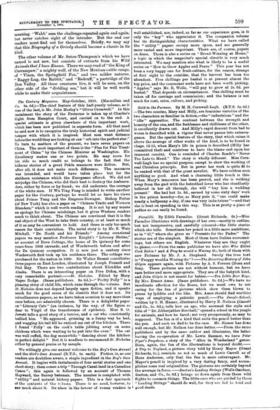The Century Magazine. May-October, 1900. (Macmillan and Co. 8s. 6d.)—The
chief feature of this half-yearly volume, as it was of the last, is Mr. John Morley's "Oliver Cromwell." In this instalment the story of the Protector is taken up at Charles's flight from Hampton Court, and carried on to the end. A special estimate is given elsewhere of this important work, which has been now published in separate form. All that need be said now is to recognise the truly historical spirit and judicial temper with which it is inspired. Most men want distance before the world they are looking at can "orb into the perfect star." To turn to matters of the present, we have seven papers on China. The most important of them is the "Plea for Fair Treat- ment of China" by the Chinese Minister at Washington. His Excellency makes one or two points. He may score for his side so much credit as belongs to the fact that the hideous stories of a great Pekin massacre were fiction. But, after all, it does not make much difference. The massacre was intended, and would have taken place but for the stubborn resistance which the Europeans offered. We did not misjudge the Chinese, who did their best to destroy the Ambassa- dors, either by force or by fraud; we did underrate the courage of the white men. If Wu Ting Fang is minded to write another paper for the Century, perhaps he would let us have his views about Prince Tang and the Empress-Dowager. Bishop Potter (of New York) has also a paper on "Chinese Traits and Western Blunders," which is well worth reading. It is not by any means an apology for Chinese misdoings, but it gives Western readers much to think about. The Chinese are convinced that it is the real object of the West to take their country, or at least so much of it as may be convenient to hold. And there is only too much reason for their conviction. The serial story is by Mr. S. Weir Mitchell, "Dr. North and his Friends." Among occasional papers we may mention Professor Knight's "Literary Shrine," an account of Dove Cottage, the home of De Quincey for some years from 1809 onwards, and of Wordsworth before and after the De Quincey occupation. It is now just a century since Wordsworth first took up his residence there. The cottage was purchased for the nation in 1900. Sir Walter Besant contributes three papers on East London, illustrated by Joseph Pennell and Pail May. There are two contributions about Klondike and Alaska. There is an interesting paper on Pere Didon, with a very remarkable portrait.—St. Nicholas. Edited by Mary Mapes Dodge. (Same publishers. 8s. 6d.)—" Pretty Polly" is a pleasing story of child life, which runs through the volume. But St. Nicholas does not depend largely upon fiction, and it speaks much for the good sense of its clientele that it does not. Its miscellaneous papers, as we have taken occasion to say more than once before, are admirably chosen. There is a delightful paper on " Literary Cats" (an instance, by the way, of the figure so dear to Virgil of the transference of epithets). Miss S. 0. Jewett tells a good story of a terrier, and a cat who consistently bullied him. "He appeared, grinning in a funny way he had, and wagging his tail till he enticed me out of the kitchen. There I found ' Polly ' on the cook's table jobbing away on some chickens which were waiting to be put into the oven." The cat was well cuffed, the dog meanwhile" dancing about the kitchen in perfect delight." But it is needless to recommend St. Nicholas either by general praise or by sample.
We willingly give our annual welcome to the Boy's Own Annual and the Girl's Own Annual (R.T.S., 8s. each). Fiction is, as our readers are doubtless aware, a staple ingredient in the Boy's Own Annual. It begins with instalments of four serial stories and one short story; then comes a trip "Through Canal-land in a Canadian Canoe"; this again is followed by an account of Thomas Hayward, the Surrey batsman. The number is completed with "utility" and natural history papers. This is a fair specimeli of the contents of the v.lume. There is no need, however, to say much about it. Its niece in the favour of young readers is well established, nor, indeed, as far as our experience goes, is it only the "boy" who appreciates it. The companion volume has its distinguishing characteristics. What we have called the " utility " papers occupy more spice, and are generally more varied and more important. There are, of course, papers on dress. There is also a series on "Bread-Winning at Home," a topic in which the magazine's special clientele is very much interested. We may mention also what is likely to be a useful series on "How to Grow Apples and Pears." This year has not been a very happy one for fruit-culture, for the reason, strange at first sight to the outsider, that the harvest has been too abundant. Five shillings per bushel is at present almost the top price, and the commoner sorts have not been worth pioking. "Apples," says Mr. B. Wells, "will pay to grow at 2s. 6d. per bushel." That depends on circumstances. One shilling must be taken off for carriage and commission; and the balance is not much for rent, rates, culture, and picking.






















































 Previous page
Previous page